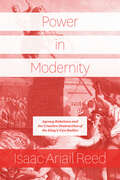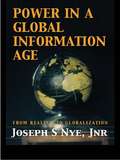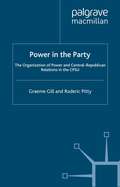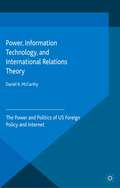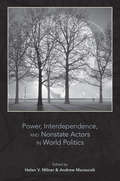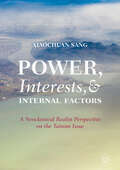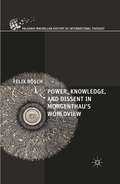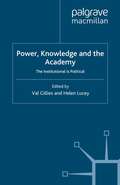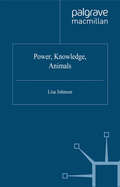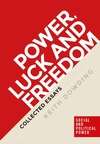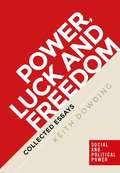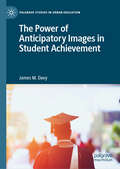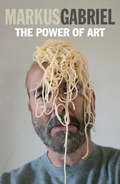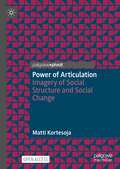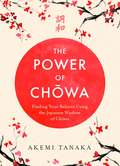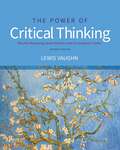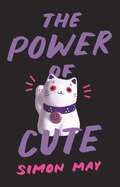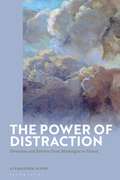- Table View
- List View
Power in Modernity: Agency Relations and the Creative Destruction of the King’s Two Bodies
by Isaac Ariail ReedIn Power in Modernity, Isaac Ariail Reed proposes a bold new theory of power that describes overlapping networks of delegation and domination. Chains of power and their representation, linking together groups and individuals across time and space, create a vast network of intersecting alliances, subordinations, redistributions, and violent exclusions. Reed traces the common action of “sending someone else to do something for you” as it expands outward into the hierarchies that control territories, persons, artifacts, minds, and money. He mobilizes this theory to investigate the onset of modernity in the Atlantic world, with a focus on rebellion, revolution, and state formation in colonial North America, the early American Republic, the English Civil War, and French Revolution. Modernity, Reed argues, dismantled the “King’s Two Bodies”—the monarch’s physical body and his ethereal, sacred second body that encompassed the body politic—as a schema of representation for forging power relations. Reed’s account then offers a new understanding of the democratic possibilities and violent exclusions forged in the name of “the people,” as revolutionaries sought new ways to secure delegation, build hierarchy, and attack alterity. Reconsidering the role of myth in modern politics, Reed proposes to see the creative destruction and eternal recurrence of the King’s Two Bodies as constitutive of the modern attitude, and thus as a new starting point for critical theory. Modernity poses in a new way an eternal human question: what does it mean to be the author of one’s own actions?
Power in Modernity: Agency Relations and the Creative Destruction of the King’s Two Bodies
by Isaac Ariail ReedIn Power in Modernity, Isaac Ariail Reed proposes a bold new theory of power that describes overlapping networks of delegation and domination. Chains of power and their representation, linking together groups and individuals across time and space, create a vast network of intersecting alliances, subordinations, redistributions, and violent exclusions. Reed traces the common action of “sending someone else to do something for you” as it expands outward into the hierarchies that control territories, persons, artifacts, minds, and money. He mobilizes this theory to investigate the onset of modernity in the Atlantic world, with a focus on rebellion, revolution, and state formation in colonial North America, the early American Republic, the English Civil War, and French Revolution. Modernity, Reed argues, dismantled the “King’s Two Bodies”—the monarch’s physical body and his ethereal, sacred second body that encompassed the body politic—as a schema of representation for forging power relations. Reed’s account then offers a new understanding of the democratic possibilities and violent exclusions forged in the name of “the people,” as revolutionaries sought new ways to secure delegation, build hierarchy, and attack alterity. Reconsidering the role of myth in modern politics, Reed proposes to see the creative destruction and eternal recurrence of the King’s Two Bodies as constitutive of the modern attitude, and thus as a new starting point for critical theory. Modernity poses in a new way an eternal human question: what does it mean to be the author of one’s own actions?
Power in Modernity: Agency Relations and the Creative Destruction of the King’s Two Bodies
by Isaac Ariail ReedIn Power in Modernity, Isaac Ariail Reed proposes a bold new theory of power that describes overlapping networks of delegation and domination. Chains of power and their representation, linking together groups and individuals across time and space, create a vast network of intersecting alliances, subordinations, redistributions, and violent exclusions. Reed traces the common action of “sending someone else to do something for you” as it expands outward into the hierarchies that control territories, persons, artifacts, minds, and money. He mobilizes this theory to investigate the onset of modernity in the Atlantic world, with a focus on rebellion, revolution, and state formation in colonial North America, the early American Republic, the English Civil War, and French Revolution. Modernity, Reed argues, dismantled the “King’s Two Bodies”—the monarch’s physical body and his ethereal, sacred second body that encompassed the body politic—as a schema of representation for forging power relations. Reed’s account then offers a new understanding of the democratic possibilities and violent exclusions forged in the name of “the people,” as revolutionaries sought new ways to secure delegation, build hierarchy, and attack alterity. Reconsidering the role of myth in modern politics, Reed proposes to see the creative destruction and eternal recurrence of the King’s Two Bodies as constitutive of the modern attitude, and thus as a new starting point for critical theory. Modernity poses in a new way an eternal human question: what does it mean to be the author of one’s own actions?
Power in Modernity: Agency Relations and the Creative Destruction of the King’s Two Bodies
by Isaac Ariail ReedIn Power in Modernity, Isaac Ariail Reed proposes a bold new theory of power that describes overlapping networks of delegation and domination. Chains of power and their representation, linking together groups and individuals across time and space, create a vast network of intersecting alliances, subordinations, redistributions, and violent exclusions. Reed traces the common action of “sending someone else to do something for you” as it expands outward into the hierarchies that control territories, persons, artifacts, minds, and money. He mobilizes this theory to investigate the onset of modernity in the Atlantic world, with a focus on rebellion, revolution, and state formation in colonial North America, the early American Republic, the English Civil War, and French Revolution. Modernity, Reed argues, dismantled the “King’s Two Bodies”—the monarch’s physical body and his ethereal, sacred second body that encompassed the body politic—as a schema of representation for forging power relations. Reed’s account then offers a new understanding of the democratic possibilities and violent exclusions forged in the name of “the people,” as revolutionaries sought new ways to secure delegation, build hierarchy, and attack alterity. Reconsidering the role of myth in modern politics, Reed proposes to see the creative destruction and eternal recurrence of the King’s Two Bodies as constitutive of the modern attitude, and thus as a new starting point for critical theory. Modernity poses in a new way an eternal human question: what does it mean to be the author of one’s own actions?
Power in Modernity: Agency Relations and the Creative Destruction of the King’s Two Bodies
by Isaac Ariail ReedIn Power in Modernity, Isaac Ariail Reed proposes a bold new theory of power that describes overlapping networks of delegation and domination. Chains of power and their representation, linking together groups and individuals across time and space, create a vast network of intersecting alliances, subordinations, redistributions, and violent exclusions. Reed traces the common action of “sending someone else to do something for you” as it expands outward into the hierarchies that control territories, persons, artifacts, minds, and money. He mobilizes this theory to investigate the onset of modernity in the Atlantic world, with a focus on rebellion, revolution, and state formation in colonial North America, the early American Republic, the English Civil War, and French Revolution. Modernity, Reed argues, dismantled the “King’s Two Bodies”—the monarch’s physical body and his ethereal, sacred second body that encompassed the body politic—as a schema of representation for forging power relations. Reed’s account then offers a new understanding of the democratic possibilities and violent exclusions forged in the name of “the people,” as revolutionaries sought new ways to secure delegation, build hierarchy, and attack alterity. Reconsidering the role of myth in modern politics, Reed proposes to see the creative destruction and eternal recurrence of the King’s Two Bodies as constitutive of the modern attitude, and thus as a new starting point for critical theory. Modernity poses in a new way an eternal human question: what does it mean to be the author of one’s own actions?
Power in the Global Information Age: From Realism to Globalization
by Joseph S. Nye Jr.One of the most brilliant and influential international relations scholars of his generation, Joseph S. Nye Jr. is one of the few academics to have served at the very highest levels of US government. This volume collects together many of his key writings for the first time as well as new material, and an important concluding essay which examines the relevance of international relations in practical policymaking.This book addresses:* America's post-Cold War role in international affairs* the ethics of foreign policy* the information revolution* terrorism.
Power in the Global Information Age: From Realism to Globalization
by Joseph S. Nye Jr.One of the most brilliant and influential international relations scholars of his generation, Joseph S. Nye Jr. is one of the few academics to have served at the very highest levels of US government. This volume collects together many of his key writings for the first time as well as new material, and an important concluding essay which examines the relevance of international relations in practical policymaking.This book addresses:* America's post-Cold War role in international affairs* the ethics of foreign policy* the information revolution* terrorism.
Power in the Party: The Organization of Power and Central-Republican Relations in the CPSU
by G. Gill R. PittyThis book examines the course of official criticism of republican leaderships in the Communist Party of the Soviet Union from Stalin's death until the collapse of central control in the late 1980s. It focuses upon five republics, Uzbekistan, Tajikistan, Kazakhstan, Ukraine and Belorussia. The extraordinary power of the central leadership to replace particular republican leaders is contrasted with the continuing dominance of elite politics in these republics by local cliques with substantial and increasing autonomy from Moscow.
Power, Information Technology, and International Relations Theory: The Power and Politics of US Foreign Policy and the Internet (Palgrave Studies in International Relations)
by D. McCarthyThis book examines the internet as a form of power in global politics. Focusing on the United States' internet foreign policy, McCarthy combines analyses of global material culture and international relation theory, to reconsider how technology is understood as a form of social power.
Power, Interdependence, and Nonstate Actors in World Politics
by Helen V. Milner Andrew MoravcsikSince they were pioneered in the 1970s by Robert Keohane and others, the broad range of neoliberal institutionalist theories of international relations have grown in importance. In an increasingly globalized world, the realist and neorealist focus on states, military power, conflict, and anarchy has more and more given way to a recognition of the importance of nonstate actors, nonmilitary forms of power, interdependence, international institutions, and cooperation. Drawing together a group of leading international relations theorists, this book explores the frontiers of new research on the role of such forces in world politics. The topics explored in these chapters include the uneven role of peacekeepers in civil wars, the success of human rights treaties in promoting women's rights, the disproportionate power of developing countries in international environmental policy negotiations, and the prospects for Asian regional cooperation. While all of the chapters demonstrate the empirical and theoretical vitality of liberal and institutionalist theories, they also highlight weaknesses that should drive future research and influence the reform of foreign policy and international organizations. In addition to the editors, the contributors are Vinod Aggarawal, Jonathan Aronson, Elizabeth DeSombre, Page Fortna, Michael Gilligan, Lisa Martin, Timothy McKeown, Ronald Mitchell, Layna Mosley, Beth Simmons, Randall Stone, and Ann Tickner.
Power, Interdependence, and Nonstate Actors in World Politics
by Helen V. Milner Andrew MoravcsikSince they were pioneered in the 1970s by Robert Keohane and others, the broad range of neoliberal institutionalist theories of international relations have grown in importance. In an increasingly globalized world, the realist and neorealist focus on states, military power, conflict, and anarchy has more and more given way to a recognition of the importance of nonstate actors, nonmilitary forms of power, interdependence, international institutions, and cooperation. Drawing together a group of leading international relations theorists, this book explores the frontiers of new research on the role of such forces in world politics. The topics explored in these chapters include the uneven role of peacekeepers in civil wars, the success of human rights treaties in promoting women's rights, the disproportionate power of developing countries in international environmental policy negotiations, and the prospects for Asian regional cooperation. While all of the chapters demonstrate the empirical and theoretical vitality of liberal and institutionalist theories, they also highlight weaknesses that should drive future research and influence the reform of foreign policy and international organizations. In addition to the editors, the contributors are Vinod Aggarawal, Jonathan Aronson, Elizabeth DeSombre, Page Fortna, Michael Gilligan, Lisa Martin, Timothy McKeown, Ronald Mitchell, Layna Mosley, Beth Simmons, Randall Stone, and Ann Tickner.
Power, Interests, and Internal Factors: A Neoclassical Realist Perspective on the Taiwan Issue
by Xiaochuan SangThis book frames the contentious political disputes surrounding Taiwan within the perspective of neorealist political theory. Analyzing the motives and relative importance that the actors involved bring to bear, Dr. Sang offers a timely intervention and a much-needed reality check on the role that Taiwan plays in structuring US-China-Japan trilateral relations—an issue that will dominate the years to come. This book will be of value to scholars, policymakers, and all those concerned with the future of Taiwan.
Power, Knowledge, and Dissent in Morgenthau's Worldview (The Palgrave Macmillan History of International Thought)
by Felix RöschThis book provides a comprehensive investigation into Hans Morgenthau's life and work. Identifying power, knowledge, and dissent as the fundamental principles that have informed his worldview, this book argues that Morgenthau's lasting contribution to the discipline of International Relations is the human condition of politics.
Power, Knowledge and the Academy: The Institutional is Political
by V. Gillies H. LuceyThis book takes a close-up and critical look at both the elusive and blatant workings and consequences of power in a range of everyday sites in universities. Chapters focus on specific locations in which power shapes personal and institutional knowledge including student-supervisor relationships, research teams, networking, and literature reviews.
Power, Knowledge, Animals (The Palgrave Macmillan Animal Ethics Series)
by L. JohnsonThis work contributes to the development of a theoretical context of the politics of truth about animals. By applying and extending Foucault's theory of power, this work uncovers dominant and subjugated discourses about animals and describes power-knowledge associated with statements about animals that are understood to convey true things.
Power, luck and freedom: Collected essays (PDF)
by Keith DowdingKeith Dowding is a major figure in relation to debates on power and highly influential in the fields of political theory and political science. Power luck and freedom is a collection of his essays and articles, that provide a significant reference point for the field of power analysis.
Power, luck and freedom: Collected essays (Social And Political Power Mup Ser.)
by Keith DowdingKeith Dowding is a major figure in relation to debates on power and highly influential in the fields of political theory and political science. Power luck and freedom is a collection of his essays and articles, that provide a significant reference point for the field of power analysis.
The Power of Anticipatory Images in Student Achievement (Palgrave Studies in Urban Education)
by James M. DavyThis book features ten high academically achieving, low-income, inner city students from Newark, New Jersey, who graduated from public high schools at or near the top of their class and continued to excel in college. Using a qualitative research design, the author interviewed the ten students and the person who most influenced their educational progress about what motivated them to achieve at such high levels. Three mutually reinforcing anticipatory images emerged as a common element of their stories. In their own voices, the students describe the anticipatory images they framed, how they developed them, and how they used them to their advantage. Davy advances a theoretical model of the Anticipatory Competent student who continually progresses in the directions of the images projected ahead.
The Power of Art
by Markus GabrielWe live in an era of aesthetics. Art has become both pervasive and powerful – it is displayed not only in museums and galleries but also on the walls of corporations and it is increasingly fused with design. But what makes art so powerful, and in what does its power consist? According to a widespread view, the power of art – its beauty – lies in the eye of the beholder. What counts as art appears to be a function of individual acts of evaluation supported by powerful institutions. On this account, the power of art stems from a force that is not itself aesthetic, such as the art market and the financial power of speculators. Art expresses, in a disguised form, the power of something else – like money – that lies behind it. In one word, art has lost its autonomy. In this short book, Markus Gabriel rejects this view. He argues that art is essentially uncontrollable. It is in the nature of the work of art to be autonomous to such a degree that the art world will never manage to overpower it. Ever since the cave paintings of Lascaux, art has taken hold of the human mind and implemented itself in our very being. Thanks to the emergence of art we became human beings, that is, beings who lead their lives in light of an image of the human being and its position in the world and in relation to other species. Due to its structural, ontological power, art itself is and remains radically autonomous. Yet, this power is highly ambiguous, as we cannot control its unfolding. In this book, a leading proponent of New Realism applies this philosophical perspective to art to create a new aesthetic realism.
Power of Articulation: Imagery of Social Structure and Social Change
by Matti KortesojaThis open access book is the first book that attempts to treat the notion of articulation as an important concept to be added to the lexicon of communication studies and social science. It constitutes the first comprehensive and systematic discussion of ‘articulation’ in English, providing an introduction of its usages and what has occurred on its ‘travels’ from one theoretical realm to another in political philosophy, structural linguistics, new economic anthropology, cultural studies and post-Marxist discourse theory. The proposed research takes a relational approach to society and social action in a way that recognises their relative autonomy. It entails an introduction of the ‘discursive turn’ in the imagery of society and social change, thereby proving that the relational concept of articulation/Gliederung has potential to consider society as both a structured, complex whole and a product of human interaction.
The Power of Chowa: Finding Your Balance Using the Japanese Wisdom of Chowa
by Akemi TanakaThe Japanese wisdom of chowa offers a fresh perspective on how to live, and new ways both to make space and find balance among the many different directions that modern life pulls us in.Chowa is a Japanese concept that is often translated as 'harmony', but more accurately means 'the search for balance'. Chowa is both a philosophy and a set of practices that can help us get to the heart of what is most important to us, and change our way of thinking about ourselves and others. This book will teach you how to apply the lessons of chowa to your own life to better focus on what really matters and cultivate an everyday state of equilibrium and calm that will help you feel ready for anything. Chowa helps us to better balance our priorities and our relationships and find inner strength and flexibility in times of change and difficulty.Whether you are searching for balance at home, at work, in your relationships or in any other area of your life, chowa offers new solutions and a way of thinking that we could all benefit from, now more than ever.
The Power of Critical Thinking: Effective Reasoning about Ordinary and Extraordinary Claims
by Lewis VaughnThe Power of Critical Thinking: Effective Reasoning About Ordinary and Extraordinary Claims, Seventh Edition, provides the broadest range of tools to show students how critical thinking applies in their lives and the world around them. It explores the essentials of critical reasoning, argumentation, logic, and argumentative essay writing while also incorporating important topics that most other texts leave out, such as "inference to the best explanation," scientific reasoning, evidence and authority, visual reasoning, and obstacles to critical thinking.
The Power of Cute
by Simon MayAn exploration of cuteness and its immense hold on us, from emojis and fluffy puppies to its more uncanny, subversive expressionsCuteness has taken the planet by storm. Global sensations Hello Kitty and Pokémon, the works of artists Takashi Murakami and Jeff Koons, Heidi the cross-eyed opossum and E.T.—all reflect its gathering power. But what does “cute” mean, as a sensibility and style? Why is it so pervasive? Is it all infantile fluff, or is there something more uncanny and even menacing going on—in a lighthearted way? In The Power of Cute, Simon May provides nuanced and surprising answers.We usually see the cute as merely diminutive, harmless, and helpless. May challenges this prevailing perspective, investigating everything from Mickey Mouse to Kim Jong-il to argue that cuteness is not restricted to such sweet qualities but also beguiles us by transforming or distorting them into something of playfully indeterminate power, gender, age, morality, and even species. May grapples with cuteness’s dark and unpindownable side—unnerving, artful, knowing, apprehensive—elements that have fascinated since ancient times through mythical figures, especially hybrids like the hermaphrodite and the sphinx. He argues that cuteness is an addictive antidote to today’s pressured expectations of knowing our purpose, being in charge, and appearing predictable, transparent, and sincere. Instead, it frivolously expresses the uncertainty that these norms deny: the ineliminable uncertainty of who we are; of how much we can control and know; of who, in our relations with others, really has power; indeed, of the very value and purpose of power.The Power of Cute delves into a phenomenon that speaks with strange force to our age.
The Power of Cute
by Simon MayAn exploration of cuteness and its immense hold on us, from emojis and fluffy puppies to its more uncanny, subversive expressionsCuteness has taken the planet by storm. Global sensations Hello Kitty and Pokémon, the works of artists Takashi Murakami and Jeff Koons, Heidi the cross-eyed opossum and E.T.—all reflect its gathering power. But what does “cute” mean, as a sensibility and style? Why is it so pervasive? Is it all infantile fluff, or is there something more uncanny and even menacing going on—in a lighthearted way? In The Power of Cute, Simon May provides nuanced and surprising answers.We usually see the cute as merely diminutive, harmless, and helpless. May challenges this prevailing perspective, investigating everything from Mickey Mouse to Kim Jong-il to argue that cuteness is not restricted to such sweet qualities but also beguiles us by transforming or distorting them into something of playfully indeterminate power, gender, age, morality, and even species. May grapples with cuteness’s dark and unpindownable side—unnerving, artful, knowing, apprehensive—elements that have fascinated since ancient times through mythical figures, especially hybrids like the hermaphrodite and the sphinx. He argues that cuteness is an addictive antidote to today’s pressured expectations of knowing our purpose, being in charge, and appearing predictable, transparent, and sincere. Instead, it frivolously expresses the uncertainty that these norms deny: the ineliminable uncertainty of who we are; of how much we can control and know; of who, in our relations with others, really has power; indeed, of the very value and purpose of power.The Power of Cute delves into a phenomenon that speaks with strange force to our age.
The Power of Distraction: Diversion and Reverie from Montaigne to Proust
by Alessandra AloisiFrom Pascal to contemporary anxieties about attention, we have constantly been urged to avoid distraction if we want to live and work better. But Alessandra Aloisi argues that we are missing the point.Drawing on a broad range ofEuropean philosophy and literature, this book considers distraction not as an expression of human imperfection, but as a creative, subversive, and aesthetic capability. In contrast to the traditional accounts, from Saint Augustine to Robert Burton, which either associated distraction with sin or considered it as a symptom of melancholy, Aloisi argues that it is often precisely when we stop thinking about something that inspiration finds us. Why else are artists described as having their heads in the clouds? This book demonstrates the serendipity of distraction through close readings of cultural and visual sources ranging from the mathematician Poincaré to the Netflix show, Black Mirror.With inspiration from La Bruyère, Rousseau, Leopardi, Stendhal, Baudelaire, and others, Aloisi further examines the political value of distraction. After all, in an age of ubiquitous technology and 24/7 availability fighting for our attention, distraction provides what Bergson called a 'slight revolt' from the codes and behaviors that society dictates.Combining philosophy, literature, art, and politics, The Power of Distraction encourages us to think differently about our attention and considers just how productive daydreams can be.
